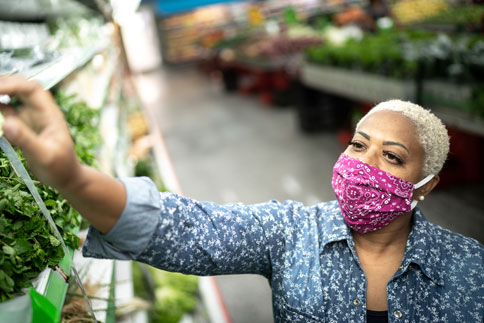COVID-19 and Food Safety
Do you have FOGO (Fear Of Going Out)? Does a trip for groceries feel as dangerous as swimming with sharks? When you get home, are you worried about what might be lurking on your bags and food items?
According to the Centers for Disease Control and Prevention (CDC), coronaviruses spread from person-to-person through respiratory droplets when someone coughs, sneezes or talks. The more closely you interact with others and the longer that interaction, the higher your risk of COVID-19 infection.
The good news is that the CDC says there is no evidence to suggest COVID-19 has been transmitted by touching food, food packaging or shopping bags. Therefore, the risk for getting COVID-19 from touching a surface or object — including food or food packaging — is low. Reinforcing proper hand hygiene and food safety practices are still recommended to keep your risk down and you safe!
After shopping and handling food packages, always wash your hands with soap and water for at least 20 seconds. If soap and water are not available, use a hand sanitizer that contains at least 60% alcohol. Cover all surfaces of your hands and rub them together until they feel dry.
Other practices to keep you safe and risk low include wearing a mask for protection, keeping a distance of six feet away from shoppers, using disinfecting wipes on your cart or basket handles, and limiting contact with your face.
Make a Plan
- Reduce the time spent in the store by creating plan. Create and organize a grocery list that prevents idle time and running back and forth between aisles.
- Shop in bulk by buying shelf-stable products and frozen foods.
Keep It Clean
- Regularly clean and disinfect kitchen counters using a commercially available disinfectant product or a homemade disinfecting solution with 5 tablespoons (⅓ cup) unscented liquid chlorine bleach to 1 gallon of water or 4 teaspoons of bleach per quart of water. Leave the solution on the surface for at least 1 minute. Before preparing food on the kitchen counter, rinse disinfected surface with water.
- DO NOT use disinfecting products on food or food packaging.
- Clean and disinfect “high-touch” surfaces daily such as tables, doorknobs, light switches, countertops, handles, desks, phones, keyboards, toilets, faucets, sinks, etc.
- If you use reusable shopping bags, ensure they are cleaned or washed before each use.
- Reduce contamination by separating ready to eat foods, fruits and vegetables, from raw meats, poultry and seafood.
Handling Fresh Produce
- Before preparing and eating food, wash your hands.
- DO NOT wash produce with soap, bleach, sanitizer, alcohol, disinfectant or any other chemical.
- Gently rinse fresh fruits and vegetables under cold, running tap water.
- Scrub uncut firm produce (e.g., potatoes, cucumbers, melons) with a clean brush — even if you don’t plan to eat the peel. When you cut into the produce, your knife will transfer the contaminates on the outside to the inside.
- Salt, pepper, vinegar, lemon juice and lime juice have not been shown to be effective at removing germs on produce.
Take a Break with Takeout
Support your local restaurants.
- Order and pay online or over the phone when possible.
- To minimize your interactions with others, have your meal delivered at home or pick it up by via drive-through, take-out or curb-side pick-up.
- Avoid in-person contact or stay at least 6 feet away from others.
- Wash your hands with soap and water or use hand sanitizer with at least 60% alcohol after picking up your food.
- Keep it nutritious to promote a healthy immune system. Try selecting grilled vs. fried. Or swap out those fries for some veggies!
